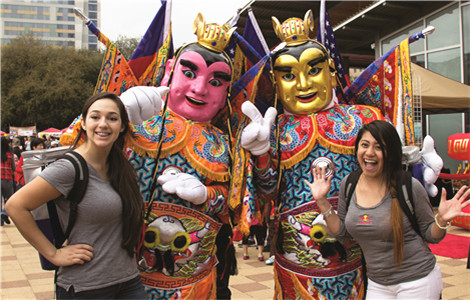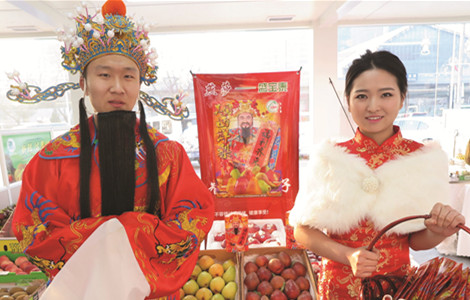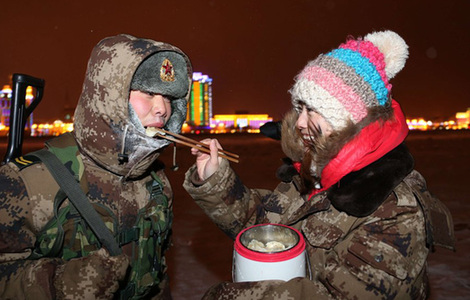Carnival gets Chinese touches
Updated: 2015-02-23 05:53
By JI YE in Rio de Janeiro(China Daily Latin America)
|
||||||||
 |
|
Revelers from Portela Samba School take part in the Carnival parade at the Sambadrome in Rio de Janiero, Brazil on Feb 16. [Photo by Xu Zijian / Xinhua] |
Brazil's Carnival season wrapped up on Feb 18 after days and nights of street celebrations throughout most of the country’s big cities, including Rio de Janeiro, Salvador, Sao Paulo and Recife.
Brazil is far away from China, and few Chinese people watch the Carnival, still Brazil’s most important extravaganza is full of Chinese elements, from made-in-China decorations to the elaborate costumes worn by revelers.
Zheng Xiamao, an overseas Chinese entrepreneur in Rio, has been in the business of Carnival decorations for 10 years, every season importing his wares from China. Since the products from China offer higher quality at lower prices, they are popular among Brazilians.
According to Zheng, decorations from China are usually in short supply and orders need to be delivered the previous year in October or November. This season Zheng imported a variety of products, some of which he sold in his own retail store and some he distributed to wholesalers in Bahia, Goias and elsewhere.
Virtually every kind of Carnival decoration was available in Zheng’s store, from fancy dresses and colored wigs to light sticks, handcuffs and pacifiers, most of which were produced in China’s Zhejiang and Guangdong provinces.
Zheng found that Brazilans like temporary tattoos and this year he ordered a batch of tattoo stickers from China which sold well.
The top professional groups in Rio’s samba parade also depend on Chinese products.
Jayder Soares, president of Grande Rio Samba School, said that this year about 70 percent of his performers’ costumes are from China.
There have been more and more foreigners interested in participating in the hotly contested samba competitions. Chinese correspondent Yang Tanli is one of them.
Posted in Rio, Yang has watched the Carnival parades for three years. This time around, in order to be more a part of the festival, she decided to participate as an extra.
The night Yang’s samba school was to perform, it suddenly started raining. But nothing could dampen the crowd’s enthusiasm and though drenched the revelers and performers went on.
Deeply moved by the spirit of the Brazilian people, Yang spared no effort in performing in the hour-long show, even though she got extremely tired, wearing the heavy costume and ornaments and dancing the whole time.
In recent year, Rio’s professional samba schools have had to find outside sponsors to supplement the government funding they receive. Some schools have expressed an interest in cooperating with Chinese companies.
During Carnival in the Brazilian capital of Brasilia three years ago, a large Chinese dragon float bearing a Chinese palace and terracotta warriors got a standing ovation. However it was one of very few things from China in the famous Brazil Carnival.
Soares said that as a symbol of Brazilian culture, the samba could act as a booster to cultural exchanges between Brazil and China. He said he hopes to carry out in-depth cooperation with Chinese enterprises during Carnival and to incorporate more Chinese elements into his samba school.
"Although Brazil and China are both BRICS countries and cooperate in many ways, most Brazilians still don't know much about what real China looks like," Ricardo Fernandes, a Carnival director, said in a recent interview.
"Carnival is one of the most popular cultural activities in Brazil. Showing Chinese cultural elements during Carnival may be the best way to help Brazilians learn more about China," Fernandes said.

 Texas Lunar Festival fun
Texas Lunar Festival fun
 Stars arrive at 87th Academy Awards
Stars arrive at 87th Academy Awards
 'God of Wealth' promotes US pears
'God of Wealth' promotes US pears
 Man's best friend: border soldiers and a military dog
Man's best friend: border soldiers and a military dog
 Couple sentries guard China's northern border during traditional holiday
Couple sentries guard China's northern border during traditional holiday
 Another winter storm to pummel eastern United States
Another winter storm to pummel eastern United States
 2015 Film Independent Spirit Awards
2015 Film Independent Spirit Awards
 Beautiful sceneries of early spring flowers around China
Beautiful sceneries of early spring flowers around China
Most Viewed
Editor's Picks

|

|

|

|

|

|
Today's Top News
Savoring benefits of medicinal foods
Alejandro G. Inarritu wins Best Director for 'Birdman'
Chinese enjoy shopping, massages and travel to ring in New Year
Foreign minister to preside at UN
Innovation bright spot as economy slows down
Ballet appreciated as form of valuable cultural exchange
Climate pact offers improved relations
Four Chinese among top 100 for Mars One project
US Weekly

|

|







